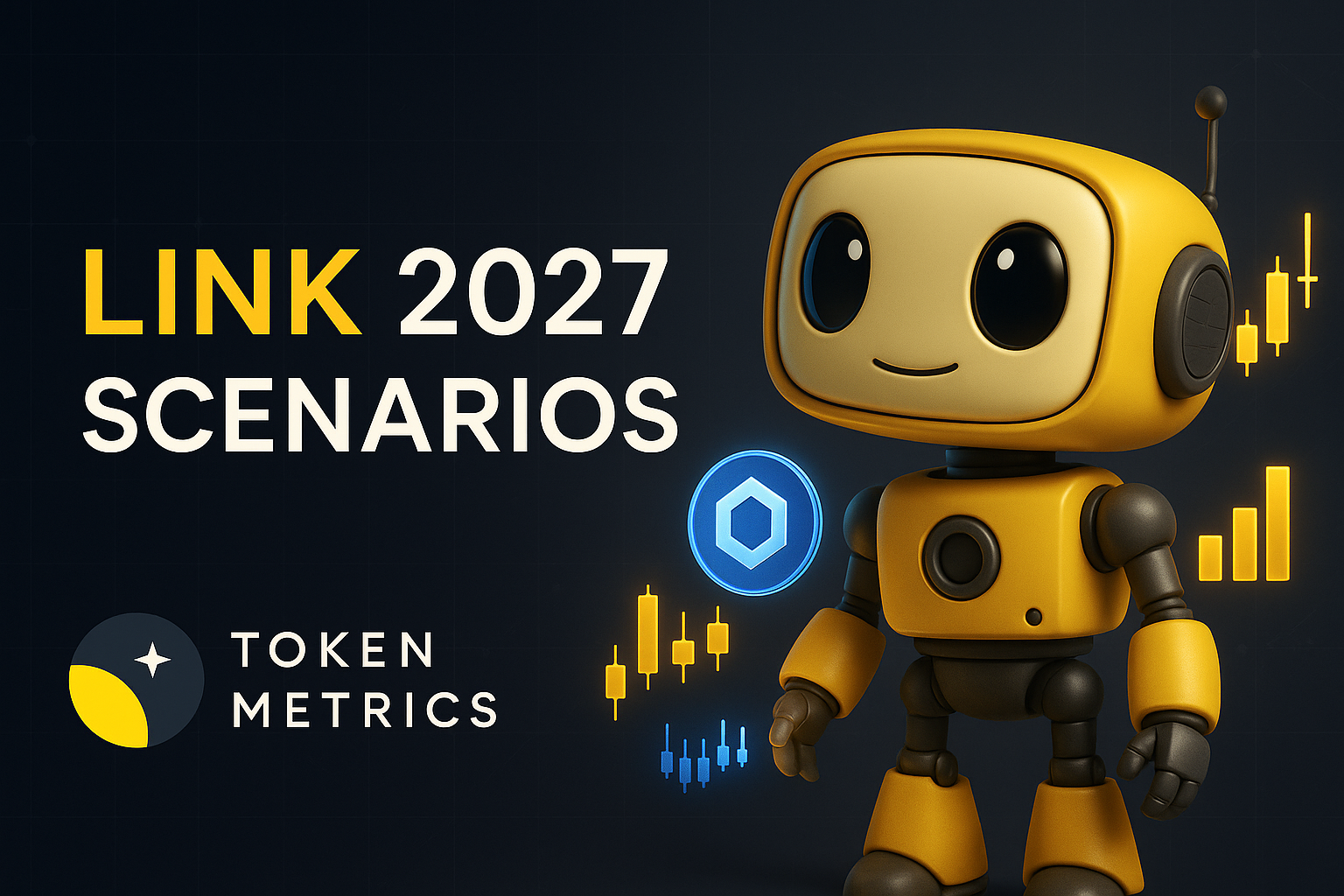Top Crypto Trading Platforms in 2025







%201.svg)
%201.svg)
Big news: We’re cranking up the heat on AI-driven crypto analytics with the launch of the Token Metrics API and our official SDK (Software Development Kit). This isn’t just an upgrade – it's a quantum leap, giving traders, hedge funds, developers, and institutions direct access to cutting-edge market intelligence, trading signals, and predictive analytics.
Crypto markets move fast, and having real-time, AI-powered insights can be the difference between catching the next big trend or getting left behind. Until now, traders and quants have been wrestling with scattered data, delayed reporting, and a lack of truly predictive analytics. Not anymore.
The Token Metrics API delivers 32+ high-performance endpoints packed with powerful AI-driven insights right into your lap, including:
Getting started with the Token Metrics API is simple:
At Token Metrics, we believe data should be decentralized, predictive, and actionable.
The Token Metrics API & SDK bring next-gen AI-powered crypto intelligence to anyone looking to trade smarter, build better, and stay ahead of the curve. With our official SDK, developers can plug these insights into their own trading bots, dashboards, and research tools – no need to reinvent the wheel.
%201.svg)
%201.svg)
Infrastructure protocols become more valuable as the crypto ecosystem scales and relies on robust middleware. Chainlink provides critical oracle infrastructure where proven utility and deep integrations drive long-term value over retail speculation. Increasing institutional adoption raises demand for professional-grade data delivery and security.
Token Metrics projections for LINK below span multiple total market cap scenarios from conservative to aggressive. Each tier assumes different levels of infrastructure demand as crypto evolves from speculative markets to institutional-grade systems. These bands frame LINK's potential outcomes into 2027.

Disclosure
Educational purposes only, not financial advice. Crypto is volatile, do your own research and manage risk.
How to read it: Each band blends cycle analogues and market-cap share math with TA guardrails. Base assumes steady adoption and neutral or positive macro. Moon layers in a liquidity boom. Bear assumes muted flows and tighter liquidity.
TM Agent baseline: Token Metrics lead metric for Chainlink, cashtag $LINK, is a TM Grade of 23.31%, which translates to a Sell, and the trading signal is bearish, indicating short-term downward momentum. This means Token Metrics currently does not endorse $LINK as a long-term buy at current conditions.
Live details: Chainlink Token Details
Affiliate Disclosure: We may earn a commission from qualifying purchases made via this link, at no extra cost to you.
Token Metrics scenarios span four market cap tiers, each representing different levels of crypto market maturity and liquidity:
8T: At an 8 trillion dollar total crypto market cap, LINK projects to $26.10 in bear conditions, $30.65 in the base case, and $35.20 in bullish scenarios.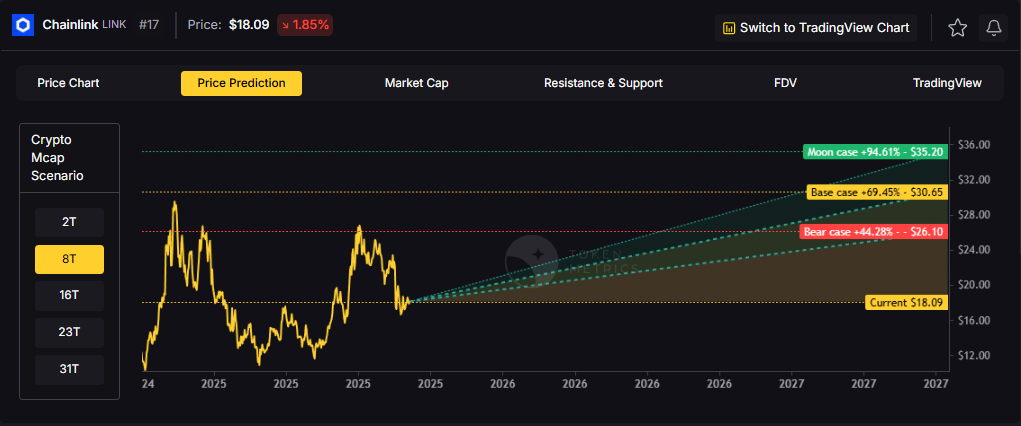
16T: Doubling the market to 16 trillion expands the range to $42.64 (bear), $56.29 (base), and $69.95 (moon).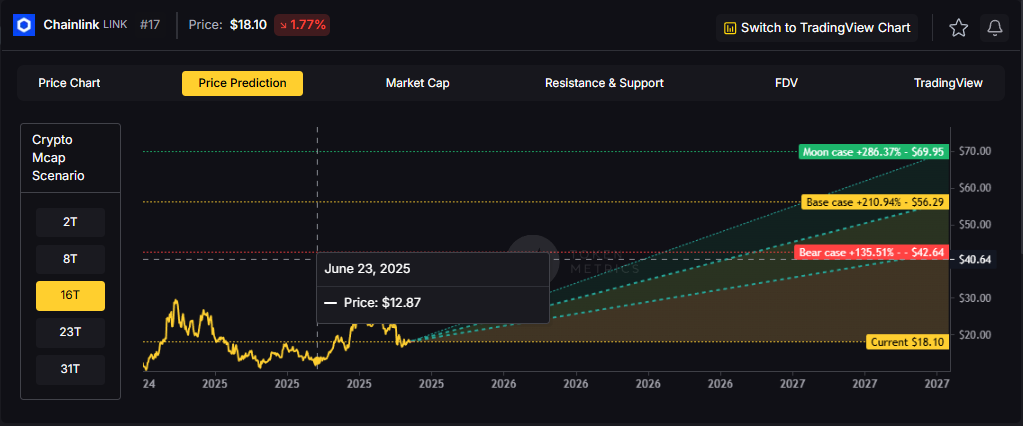
23T: At 23 trillion, the scenarios show $59.18, $81.94, and $104.70 respectively.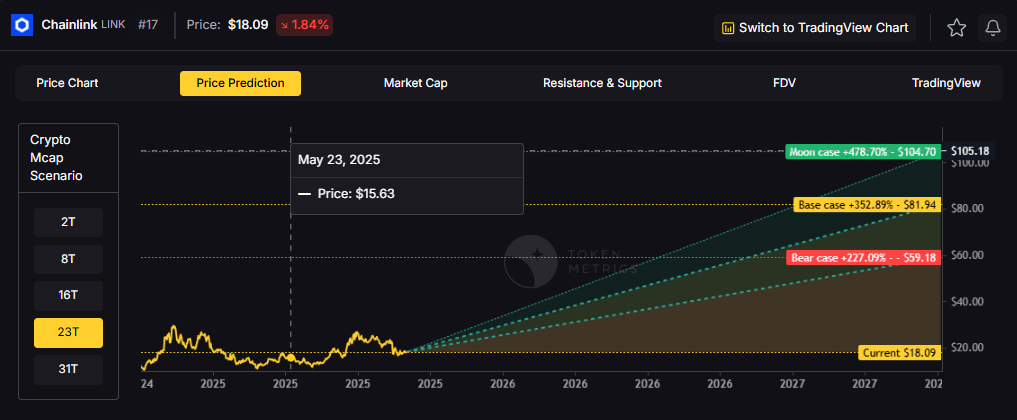
31T: In the maximum liquidity scenario of 31 trillion, LINK could reach $75.71 (bear), $107.58 (base), or $139.44 (moon).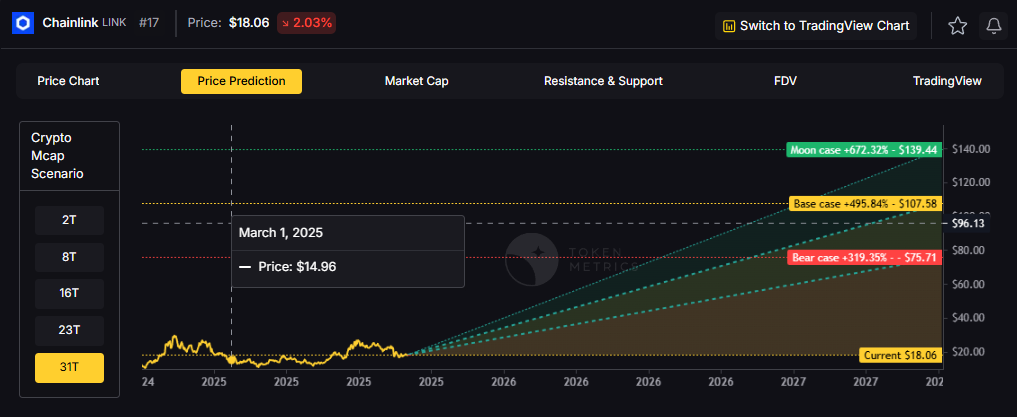
Chainlink represents one opportunity among hundreds in crypto markets. Token Metrics Indices bundle LINK with top one hundred assets for systematic exposure to the strongest projects. Single tokens face idiosyncratic risks that diversified baskets mitigate.
Historical index performance demonstrates the value of systematic diversification versus concentrated positions.
Chainlink is a decentralized oracle network that connects smart contracts to real-world data and systems. It enables secure retrieval and verification of off-chain information, supports computation, and integrates across multiple blockchains. As adoption grows, Chainlink serves as critical infrastructure for reliable data feeds and automation.
The LINK token is used to pay node operators and secure the network’s services. Common use cases include DeFi price feeds, insurance, and enterprise integrations, with CCIP extending cross-chain messaging and token transfers.
Vision: Chainlink aims to create a decentralized, secure, and reliable network for connecting smart contracts with real-world data and systems. Its vision is to become the standard for how blockchains interact with external environments, enabling trust-minimized automation across industries.
Problem: Smart contracts cannot natively access data outside their blockchain, limiting their functionality. Relying on centralized oracles introduces single points of failure and undermines the security and decentralization of blockchain applications. This creates a critical need for a trustless, tamper-proof way to bring real-world information onto blockchains.
Solution: Chainlink solves this by operating a decentralized network of node operators that fetch, aggregate, and deliver data from off-chain sources to smart contracts. It uses cryptographic proofs, reputation systems, and economic incentives to ensure data integrity. The network supports various data types and computation tasks, allowing developers to build complex, data-driven decentralized applications.
Market Analysis: Chainlink is a market leader in the oracle space and a key infrastructure component in the broader blockchain ecosystem, particularly within Ethereum and other smart contract platforms. It faces competition from emerging oracle networks like Band Protocol and API3, but maintains a strong first-mover advantage and widespread integration across DeFi, NFTs, and enterprise blockchain solutions. Adoption is driven by developer activity, partnerships with major blockchain projects, and demand for secure data feeds. Key risks include technological shifts, regulatory scrutiny on data providers, and execution challenges in scaling decentralized oracle networks. As smart contract usage grows, so does the potential for oracle services, positioning Chainlink at the center of a critical niche, though its success depends on maintaining security and decentralization over time.
Fundamental Grade: 74.58% (Community 81%, Tokenomics 100%, Exchange 100%, VC —, DeFi Scanner 17%).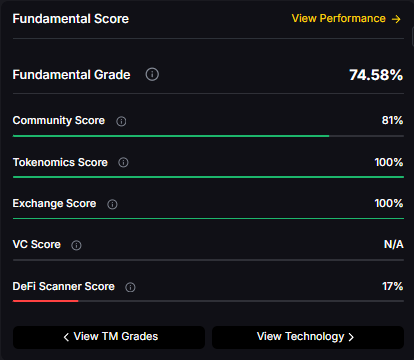
Technology Grade: 88.50% (Activity 81%, Repository 72%, Collaboration 100%, Security 86%, DeFi Scanner 17%).
Can LINK reach $100?
Yes. Based on the scenarios, LINK could reach $100+ in the 23T moon case. The 23T tier projects $104.70 in the moon case. Not financial advice.
What price could LINK reach in the moon case?
Moon case projections range from $35.20 at 8T to $139.44 at 31T. These scenarios assume maximum liquidity expansion and strong Chainlink adoption. Not financial advice.
Should I buy LINK now or wait?
Timing depends on risk tolerance and macro outlook. Current price of $18.09 sits below the 8T bear case in the scenarios. Dollar-cost averaging may reduce timing risk. Not financial advice.
Track live grades and signals: Token Details
Want exposure? Buy LINK on MEXC
Disclosure
Educational purposes only, not financial advice. Crypto is volatile, do your own research and manage risk.
Discover the full potential of your crypto research and portfolio management with Token Metrics. Our ratings combine AI-driven analytics, on-chain data, and decades of investing expertise—giving you the edge to navigate fast-changing markets. Try our platform to access scenario-based price targets, token grades, indices, and more for institutional and individual investors. Token Metrics is your research partner through every crypto market cycle.
%201.svg)
%201.svg)
The crypto market is tilting bullish into 2026 as liquidity, infrastructure, and participation improve across the board. Clearer rules and standards are reshaping the classic four-year cycle, flows can arrive earlier, and strength can persist longer than in prior expansions.
Institutional access is widening through ETFs and custody, while L2 scaling and real-world integrations help sustain on‑chain activity. This healthier backdrop frames our scenario work for HYPE. The ranges below reflect different total crypto market sizes and the share Hyperliquid could capture under each regime.
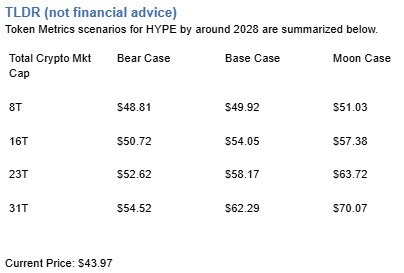
Disclosure
Educational purposes only, not financial advice. Crypto is volatile, do your own research and manage risk.
How to read it: Each band blends cycle analogues and market-cap share math with TA guardrails. Base assumes steady adoption and neutral or positive macro. Moon layers in a liquidity boom. Bear assumes muted flows and tighter liquidity.
TM Agent baseline: Token Metrics TM Grade is 73.9%, a Buy, and the trading signal is bearish, indicating short-term downward momentum. This means Token Metrics judges HYPE as fundamentally attractive over the long term, while near-term momentum is negative and may limit rallies.
Live details: Hyperliquid Token Details
Affiliate Disclosure: We may earn a commission from qualifying purchases made via this link, at no extra cost to you.
Scenario Analysis
Token Metrics scenarios span four market cap tiers, each representing different levels of crypto market maturity and liquidity:
8T: At an 8 trillion dollar total crypto market cap, HYPE projects to $48.81 in bear conditions, $49.92 in the base case, and $51.03 in bullish scenarios.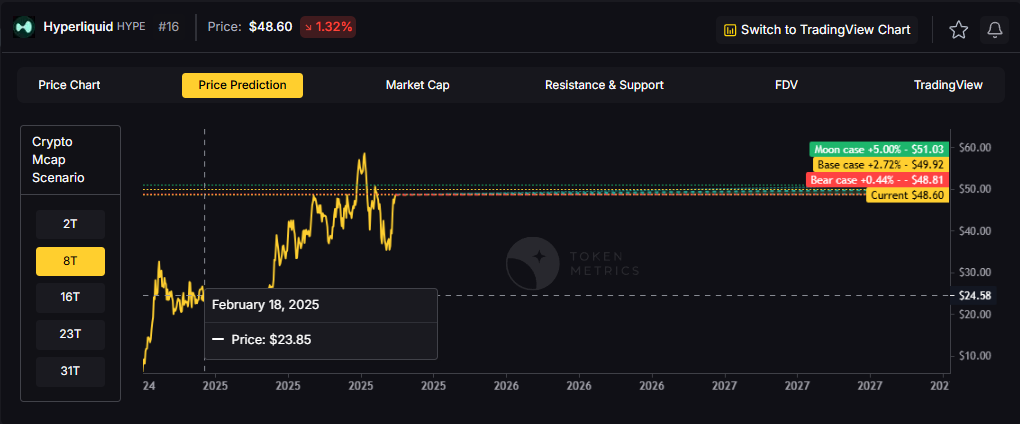
16T: Doubling the market to 16 trillion expands the range to $50.72 (bear), $54.05 (base), and $57.38 (moon).
23T: At 23 trillion, the scenarios show $52.62, $58.17, and $63.72 respectively.
31T: In the maximum liquidity scenario of 31 trillion, HYPE could reach $54.52 (bear), $62.29 (base), or $70.07 (moon).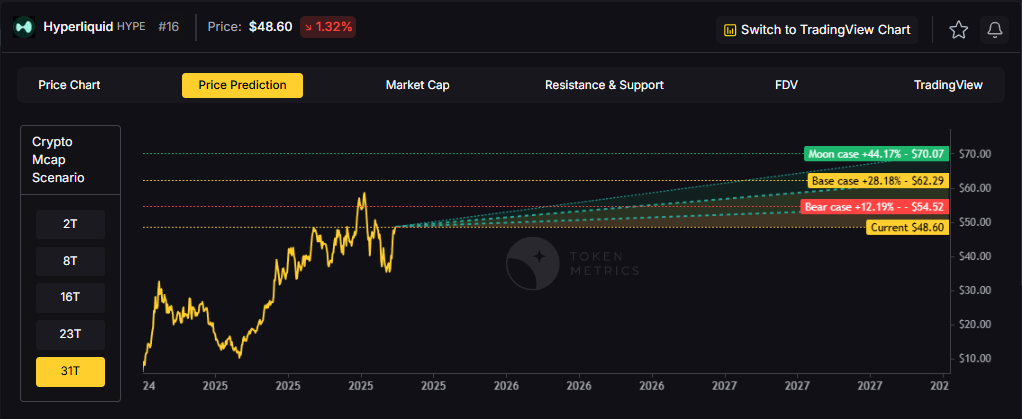
Each tier assumes progressively stronger market conditions, with the base case reflecting steady growth and the moon case requiring sustained bull market dynamics.
Diversification matters. HYPE is compelling, yet concentrated bets can be volatile. Token Metrics Indices hold HYPE alongside the top one hundred tokens for broad exposure to leaders and emerging winners.
Our backtests indicate that owning the full market with diversified indices has historically outperformed both the total market and Bitcoin in many regimes due to diversification and rotation.
Hyperliquid is a decentralized exchange focused on perpetual futures with a high-performance order book architecture. The project emphasizes low-latency trading, risk controls, and capital efficiency aimed at professional and retail derivatives traders. Its token, HYPE, is used for ecosystem incentives and governance-related utilities.
Can HYPE reach $60?
Yes, the 23T and 31T tiers imply ranges above $60 in the Base and Moon bands, though outcomes depend on liquidity and adoption. Not financial advice.
Is HYPE a good long-term investment?
Outcome depends on adoption, liquidity regime, competition, and supply dynamics. Diversify and size positions responsibly.
Disclosure
Educational purposes only, not financial advice. Crypto is volatile, do your own research and manage risk.
Token Metrics delivers AI-based crypto ratings, scenario projections, and portfolio tools so you can make smarter decisions. Discover real-time analytics on Token Metrics.
%201.svg)
%201.svg)
The Layer 1 competitive landscape is consolidating as markets recognize that specialization matters more than being a generic "Ethereum killer." Cardano positions itself in this multi-chain world with specific technical and ecosystem advantages. Infrastructure maturity around custody, bridges, and developer tools makes alternative L1s more accessible heading into 2026.
The scenario projections below map different market share outcomes for ADA across varying total crypto market sizes. Base cases assume Cardano maintains current ecosystem momentum, while moon scenarios factor in accelerated adoption and bear cases reflect increased competitive pressure.

Disclosure
Educational purposes only, not financial advice. Crypto is volatile, do your own research and manage risk.
How to read it: Each band blends cycle analogues and market-cap share math with TA guardrails. Base assumes steady adoption and neutral or positive macro. Moon layers in a liquidity boom. Bear assumes muted flows and tighter liquidity.
TM Agent baseline: Token Metrics lead metric for Cardano, cashtag $ADA, is a TM Grade of 29.72%, which translates to a Sell, and the trading signal is bearish, indicating short-term downward momentum. This combination means Token Metrics does not currently endorse $ADA as a long-term buy at current levels. A brief market context: Bitcoin's direction remains the dominant macro driver for smart contract platforms, so sustained upside for $ADA would require a broader crypto risk-on regime and improving fundamentals or developer activity for Cardano.
Live details: Cardano Token Details
Affiliate Disclosure: We may earn a commission from qualifying purchases made via this link, at no extra cost to you.
Token Metrics scenarios span four market cap tiers, each representing different levels of crypto market maturity and liquidity:




Each tier assumes progressively stronger market conditions, with the base case reflecting steady growth and the moon case requiring sustained bull market dynamics.
Cardano represents one opportunity among hundreds in crypto markets. Token Metrics Indices bundle ADA with top one hundred assets for systematic exposure to the strongest projects. Single tokens face idiosyncratic risks that diversified baskets mitigate.
Historical index performance demonstrates the value of systematic diversification versus concentrated positions.
Cardano is a blockchain platform designed to support secure, scalable, and sustainable decentralized applications and smart contracts. It is known for its research-driven development approach, emphasizing peer-reviewed academic research and formal verification methods to ensure reliability and security. As a proof-of-stake Layer 1 blockchain, Cardano aims to offer energy efficiency and long-term scalability, positioning itself as a competitor to platforms like Ethereum. Its native token, ADA, is used for transactions, staking, and governance. Adoption is driven by technological rigor and ecosystem growth, though progress has been criticized for being slow compared to more agile competitors. Risks include execution delays, competition, and market volatility.
Cardano’s vision is to create a decentralized platform that enables sustainable and inclusive economic systems through advanced cryptography and scientific methodology. It aims to bridge gaps between traditional financial systems and blockchain technology, promoting accessibility and security for users globally.
Token Metrics AI provides comprehensive context on Cardano's positioning and challenges.


Can ADA reach $4?
Based on the scenarios, ADA could reach $4 in the 31T moon case. The 31T tier projects $4.27 in the moon case. Not financial advice.
Can ADA 10x from current levels?
At current price of $0.65, a 10x would reach $6.50. This falls within none of the provided scenarios, which top out at $4.27 in the 31T moon case. Bear in mind that 10x returns require substantial market cap expansion. Not financial advice.
What price could ADA reach in the moon case?
Moon case projections range from $1.16 at 8T to $4.27 at 31T. These scenarios assume maximum liquidity expansion and strong Cardano adoption. Not financial advice.
Disclosure
Educational purposes only, not financial advice. Crypto is volatile, do your own research and manage risk.

%201.svg)
%201.svg)
REST APIs power much of the web and modern integrations—from mobile apps to AI agents that consume structured data. Understanding the principles, common pitfalls, and operational practices that make a REST API reliable and maintainable helps teams move faster while reducing friction when integrating services.
Representational State Transfer (REST) is an architectural style for networked applications. A REST API exposes resources (users, accounts, prices, etc.) via predictable HTTP endpoints and methods (GET, POST, PUT, DELETE). Its simplicity, cacheability, and wide tooling support make REST a go-to pattern for many back-end services and third-party integrations.
Key behavioral expectations include statelessness (each request contains the information needed to process it), use of standard HTTP status codes, and a resource-oriented URI design. These conventions improve developer experience and enable robust monitoring and error handling across distributed systems.
Designing a clear resource model at the outset avoids messy ad-hoc expansions later. Consider these guidelines:
Model relationships thoughtfully: prefer nested resources for clarity (e.g., /projects/42/tasks) but avoid excessive nesting depth. A well-documented schema contract reduces integration errors and accelerates client development.
Security for REST APIs is multi-layered. Common patterns:
Also consider rate limiting, token expiry, and key rotation policies. For APIs that surface sensitive data, adopt least-privilege principles and audit logging so access patterns can be reviewed.
Latency and scalability are often where APIs meet their limits. Practical levers include:
Instrument your API with observability: structured logs, distributed traces, and metrics (latency, error rates, throughput). These signals enable data-driven tuning and prioritized fixes.
Quality APIs are well-tested and easy to adopt. Include:
Automate CI checks that validate linting, schema changes, and security scanning to maintain long-term health.
When REST APIs expose market data, on-chain metrics, or signal feeds for analytics and AI agents, additional considerations apply. Data freshness, deterministic timestamps, provenance metadata, and predictable rate limits matter for reproducible analytics. Design APIs so consumers can:
AI-driven workflows often combine multiple endpoints; consistent schemas and clear quotas simplify orchestration and reduce operational surprises. For example, Token Metrics demonstrates how structured crypto insights can be surfaced via APIs to support research and model inputs for agents.
Build Smarter Crypto Apps & AI Agents with Token Metrics
Token Metrics provides real-time prices, trading signals, and on-chain insights all from one powerful API. Grab a Free API Key
"REST" refers to the architectural constraints defined by Roy Fielding. "RESTful" is an informal adjective describing APIs that follow REST principles—though implementations vary in how strictly they adhere to the constraints.
Use semantic intent when versioning. URL-based versions (e.g., /v1/) are explicit, while header-based or content negotiation approaches avoid URL churn. Regardless, document deprecation timelines and provide backward-compatible pathways.
REST is simple and cache-friendly for resource-centric models. GraphQL excels when clients need flexible queries across nested relationships. Consider client requirements, caching strategy, and operational complexity when choosing.
Expose limit headers, return standard status codes (e.g., 429), and provide retry-after guidance. Offer tiered quotas and clear documentation so integrators can design backoffs and fallback strategies.
OpenAPI (Swagger) for specs, Postman for interactive exploration, Pact for contract testing, and CI-integrated schema validators are common choices. Combine these with monitoring and API gateways for observability and enforcement.
This article is for educational and technical reference only. It is not financial, legal, or investment advice. Always evaluate tools and services against your own technical requirements and compliance obligations before integrating them into production systems.

%201.svg)
%201.svg)
REST APIs power most modern web and mobile back ends by providing a uniform, scalable way to exchange data over HTTP. Whether you are building microservices, connecting AI agents, or integrating third‑party feeds, understanding the architectural principles, design patterns, and operational tradeoffs of REST can help you build reliable systems. This article breaks down core concepts, design best practices, security measures, and practical steps to integrate REST APIs with analytics and AI workflows.
REST (Representational State Transfer) is an architectural style for distributed systems. It emphasizes stateless interactions, resource-based URIs, and the use of standard HTTP verbs (GET, POST, PUT, DELETE, PATCH). Key constraints include:
When designing APIs, aim for clear resource models, intuitive endpoint naming, and consistent payload shapes. Consider versioning strategies (URL vs header) from day one to avoid breaking clients as your API evolves.
Good API design balances usability, performance, and maintainability. Adopt these common patterns:
Document endpoints with examples and schemas (OpenAPI/Swagger). Automated documentation and SDK generation reduce integration friction and lower client-side errors.
Security and operational resilience are core concerns for production APIs. Consider the following layers:
For scale, design for statelessness so instances are replaceable, use caching (HTTP cache headers, CDN, or edge caches), and partition data to reduce contention. Use circuit breakers and graceful degradation to maintain partial service during downstream failures.
REST APIs are frequently used to feed AI models, aggregate on‑chain data, and connect analytics pipelines. Best practices for these integrations include:
To accelerate research workflows and reduce time-to-insight, many teams combine REST APIs with AI-driven analytics. For example, external platforms can provide curated market and on‑chain data through RESTful endpoints that feed model training or signal generation. One such option for consolidated crypto data access is Token Metrics, which can be used as part of an analysis pipeline to augment internal data sources.
Build Smarter Crypto Apps & AI Agents with Token Metrics
Token Metrics provides real-time prices, trading signals, and on-chain insights all from one powerful API. Grab a Free API Key
REST is an architectural style defined by constraints; "RESTful" describes services that adhere to those principles. In practice, many APIs are called RESTful even if they relax some constraints, such as strict HATEOAS.
Version early when breaking changes are likely. Common approaches are path versioning (/v1/) or header-based versioning. Path versioning is simpler for clients, while headers keep URLs cleaner. Maintain compatibility guarantees in your documentation.
REST is straightforward for resource-centric designs and benefits from HTTP caching and simple tooling. GraphQL excels when clients need flexible queries and to reduce over-fetching. Choose based on client needs, caching requirements, and team expertise.
Use token bucket or fixed-window counters, and apply limits per API key, IP, or user. Provide rate limit headers and meaningful status codes (429 Too Many Requests) to help clients implement backoff and retry strategies.
Combine unit and integration tests with contract tests (OpenAPI-driven). For monitoring, collect metrics (latency, error rates), traces, and structured logs. Synthetic checks and alerting on SLA breaches help detect degradations early.
Use OpenAPI/Swagger to provide machine-readable schemas and auto-generate interactive docs. Include examples, authentication instructions, and clear error code tables. Keep docs in version control alongside code.
Disclaimer
This article is educational and informational only. It does not constitute financial, investment, legal, or professional advice. Evaluate tools and services independently and consult appropriate professionals for specific needs.

%201.svg)
%201.svg)
REST APIs power much of the modern web, mobile apps, and integrations between services. Whether you are building a backend for a product, connecting to external data sources, or composing AI agents that call external endpoints, understanding REST API fundamentals helps you design reliable, maintainable, and performant systems.
Representational State Transfer (REST) is an architectural style that uses simple HTTP verbs to operate on resources identified by URLs. A REST API exposes these resources over HTTP so clients can create, read, update, and delete state in a predictable way. Key benefits include:
REST is not a strict protocol; it is a set of constraints that make APIs easier to consume and maintain. Understanding these constraints enables clearer contracts between services and smoother integration with libraries, SDKs, and API gateways.
Designing a RESTful API starts with resources and consistent use of HTTP semantics. Typical patterns include:
Use idempotency for safety: GET, PUT, and DELETE should be safe to retry without causing unintended side effects. POST is commonly non-idempotent unless an idempotency key is provided.
As APIs grow, practical patterns help keep them efficient and stable:
Security and reliability are essential for production APIs. Consider these practices:
These controls reduce downtime and make integration predictable for client teams and third-party developers.
Good testing and clear docs accelerate adoption and reduce bugs:
These measures improve developer productivity and reduce the risk of downstream failures when APIs evolve.
Build Smarter Crypto Apps & AI Agents with Token Metrics
Token Metrics provides real-time prices, trading signals, and on-chain insights all from one powerful API. Grab a Free API Key
REST is the architectural style; RESTful typically describes APIs that follow REST constraints such as statelessness, resource orientation, and use of HTTP verbs. In practice the terms are often used interchangeably.
PUT generally replaces a full resource and is idempotent; PATCH applies partial changes and may not be idempotent unless designed to be. Choose based on whether clients send full or partial resource representations.
URL versioning (/v1/) is simple and visible to clients, while header versioning is cleaner from a URL standpoint but harder for users to discover. Pick a strategy with a clear migration and deprecation plan.
Typical causes include unoptimized database queries, chatty endpoints that require many requests, lack of caching, and large payloads. Use profiling, caching, and pagination to mitigate these issues.
AI agents often orchestrate multiple data sources and services via REST APIs. Well-documented, authenticated, and idempotent endpoints make it safer for agents to request data, trigger workflows, and integrate model outputs into applications.
OpenAPI/Swagger, Postman, Redoc, and API gateways (e.g., Kong, Apigee) are common. They help standardize schemas, run automated tests, and generate SDKs for multiple languages.
Disclaimer
This article is educational and informational only. It does not constitute professional advice. Evaluate technical choices and platforms based on your project requirements and security needs.

%201.svg)
%201.svg)
REST APIs are the connective tissue of modern software: from mobile apps to cloud services, they standardize how systems share data. This guide breaks down practical design patterns, security considerations, performance tuning, and testing strategies to help engineers build reliable, maintainable RESTful services.
Good REST API design balances consistency, discoverability, and simplicity. Start with clear resource modeling — treat nouns as endpoints (e.g., /users, /orders) and use HTTP methods semantically: GET for retrieval, POST for creation, PUT/PATCH for updates, and DELETE for removals. Design predictable URIs, favor plural resource names, and use nested resources sparingly when relationships matter.
Other patterns to consider:
Security is foundational. Choose an authentication model that matches your use case: token-based (OAuth 2.0, JWT) is common for user-facing APIs, while mutual TLS or API keys may suit machine-to-machine communication. Regardless of choice, follow these practices:
Designate clear error codes and messages that avoid leaking sensitive information. Security reviews and threat modeling are essential parts of API lifecycle management.
Performance and scalability decisions often shape architecture. Key levers include caching, pagination, and efficient data modeling:
Leverage observability: instrument APIs with metrics (latency, error rates, throughput), distributed tracing, and structured logs. These signals help locate bottlenecks and inform capacity planning. In distributed deployments, design for graceful degradation and retries with exponential backoff to improve resilience.
Robust testing and tooling accelerate safe iteration. Adopt automated tests at multiple levels: unit tests for handlers, integration tests against staging environments, and contract tests to ensure backward compatibility. Use API mocking to validate client behavior early in development.
Versioning strategy matters: embed version in the URL (e.g., /v1/users) or the Accept header. Aim for backwards-compatible changes when possible; when breaking changes are unavoidable, document migration paths.
AI-enhanced tools can assist with schema discovery, test generation, and traffic analysis. For example, Token Metrics and similar platforms illustrate how analytics and automated signals can surface usage patterns and anomalies in request volumes — useful inputs when tuning rate limits or prioritizing endpoints for optimization.
Build Smarter Crypto Apps & AI Agents with Token Metrics
Token Metrics provides real-time prices, trading signals, and on-chain insights all from one powerful API. Grab a Free API Key
A REST API (Representational State Transfer) is an architectural style for networked applications that uses stateless HTTP requests to manipulate resources represented by URLs and standard methods.
Secure your API by enforcing HTTPS, using robust authentication (OAuth 2.0, short-lived tokens), validating inputs, applying rate limits, and monitoring access logs for anomalies.
Use POST to create resources, PUT to replace a resource entirely, and PATCH to apply partial updates. Choose semantics that align with client expectations and document them clearly.
Common approaches include URL versioning (/v1/...), header versioning (Accept header), or content negotiation. Prefer backward-compatible changes; when breaking changes are required, communicate deprecation timelines.
Return appropriate HTTP status codes, provide consistent error bodies with machine-readable codes and human-readable messages, and avoid exposing sensitive internals. Include correlation IDs to aid debugging.
Use synthetic monitoring, real-user metrics, health checks, distributed tracing, and automated alerting. Combine unit/integration tests with contract tests and post-deployment smoke checks.
Disclaimer
This article is educational and technical in nature. It does not provide financial, legal, or investment advice. Implementation choices depend on your specific context; consult qualified professionals for regulatory or security-sensitive decisions.

%201.svg)
%201.svg)
REST APIs power modern web services by defining a simple, uniform way to access and manipulate resources over HTTP. Whether you are designing an internal microservice, integrating third-party data, or building AI agents that call services programmatically, understanding REST API principles helps you build reliable, maintainable systems. This guide breaks down core concepts, design trade-offs, security controls, and practical patterns you can apply when evaluating or implementing RESTful interfaces.
REST (Representational State Transfer) is an architectural style that uses standard HTTP methods to operate on resources identified by URLs. A REST API typically returns structured representations—most commonly JSON—that describe resources such as users, transactions, or telemetry. REST is well suited for:
REST is not a silver bullet: systems requiring real-time bidirectional streams, complex RPC semantics, or strict schema contracts may favor WebSockets, gRPC, or GraphQL depending on latency and payload requirements.
Good REST design emphasizes simplicity, consistency, and discoverability. Key guidelines include:
Consider API discoverability through hypermedia (HATEOAS) if you need clients to navigate available actions dynamically. Otherwise, well-documented OpenAPI (Swagger) specifications are essential for developer experience and tooling.
Security is critical for any publicly exposed REST API. Core controls include:
For sensitive domains like crypto data feeds or identity, combine monitoring, anomaly detection, and clear incident response procedures. When aggregating external data, validate provenance and apply freshness checks.
From implementation to production readiness, the following practical steps improve reliability:
When building data-driven applications or AI agents that call APIs, consider data quality checks and retry/backoff strategies to handle transient failures gracefully. For crypto and market-data integrations, specialized providers can simplify ingestion and normalization; for example, Token Metrics is often used as an analytics layer by teams that need standardized signals and ratings.
Build Smarter Crypto Apps & AI Agents with Token Metrics
Token Metrics provides real-time prices, trading signals, and on-chain insights all from one powerful API. Grab a Free API Key
The primary methods are GET (retrieve), POST (create), PUT/PATCH (update), and DELETE (remove). Each has semantic expectations: GET should be safe and idempotent, while POST is typically non-idempotent. Use PATCH for partial updates and PUT for full replacements when appropriate.
Common strategies include URI versioning (e.g., /v1/resource), header-based versioning, or content negotiation. Regardless of approach, communicate deprecation timelines, provide migration guides, and support old versions during a transition window.
REST may be suboptimal for low-latency bidirectional communication (use WebSockets), strict schema contracts and performance-sensitive RPCs (consider gRPC), or when clients need a single call to fetch heterogeneous nested resources (GraphQL can reduce over-/under-fetching).
Maintain an OpenAPI specification, host interactive docs (Swagger UI, Redoc), and provide example requests, SDKs, and changelogs. Automated validation against the contract helps keep docs and runtime behavior aligned.
Track latency (P50/P95/P99), request throughput, error rates by endpoint and status code, database or downstream call latencies, and service saturation metrics (CPU, memory, connection counts). Combine logs, traces, and metrics for faster incident response.
This article is for educational and informational purposes only. It provides technical analysis of REST API design and operational considerations and does not constitute investment, legal, or regulatory advice. Always perform your own due diligence when integrating external services or handling sensitive data.

%201.svg)
%201.svg)
REST APIs power much of the modern web: mobile apps, single-page frontends, third-party integrations, and many backend services communicate via RESTful endpoints. This guide breaks down the core principles, design patterns, security considerations, and practical workflows for building and consuming reliable REST APIs. Whether you are evaluating an external API or designing one for production, the frameworks and checklists here will help you ask the right technical questions and set up measurable controls.
REST (Representational State Transfer) is an architectural style for networked applications that uses stateless communication, standard HTTP verbs, and resource-oriented URLs. A REST API exposes resources (users, orders, prices, metadata) as endpoints that clients can retrieve or modify. The simplicity of the model and ubiquity of HTTP make REST a common choice for public APIs and internal microservices.
Key benefits include:
Designing a good REST API starts with consistent use of HTTP semantics. The common verbs and their typical uses are:
Good RESTful design also emphasizes:
Well-documented APIs reduce integration friction and errors. Follow these practical habits:
Automate documentation generation and run contract tests as part of CI to detect regressions early.
Security and observability are essential. Practical controls and patterns include:
Security reviews and occasional red-team exercises help identify gaps beyond static checks.
Consuming and testing REST APIs fits into several common workflows:
When building sector-specific APIs — for example, price feeds or on-chain data — combining REST endpoints with streaming (webhooks or websockets) can deliver both historical queries and low-latency updates. AI-driven analytics platforms can help synthesize large API outputs into actionable signals and summaries; for example, Token Metrics and similar tools can ingest API data for model-driven analysis without manual aggregation.
Build Smarter Crypto Apps & AI Agents with Token Metrics
Token Metrics provides real-time prices, trading signals, and on-chain insights all from one powerful API. Grab a Free API Key
REST describes the architectural constraints and principles. "RESTful" is commonly used to describe APIs that follow those principles, i.e., resource-based design, stateless interactions, and use of standard HTTP verbs.
Expose a clear versioning strategy early. Path versioning (/v1/) is explicit and simple, while header or content negotiation can be more flexible. Regardless of approach, document migration timelines and provide backward compatibility where feasible.
Use PUT to replace a resource fully; use PATCH to apply partial updates. PATCH payloads should be well-defined (JSON Patch or application/merge-patch+json) to avoid ambiguity.
Offset-based pagination is easy to implement but can produce inconsistent results with concurrent writes. Cursor-based (opaque token) pagination is more robust for large, frequently changing datasets.
Use OpenAPI specs combined with contract testing tools that validate servers against the spec. Include integration tests in CI that exercise representative workflows and simulate error conditions and rate limits.
Apply tiered access controls: provide limited free access with API keys and rate limits for discovery, and require stronger auth (OAuth, signed requests) for sensitive endpoints. Clear docs and quickstart SDKs reduce friction for legitimate users.
Track latency percentiles (p50/p95/p99), error rates by status code, request volume, and authentication failures. Correlate these with infrastructure metrics and traces to identify root causes quickly.
Yes. REST APIs can serve as a data ingestion layer for AI workflows, supplying labeled data, telemetry, and features. Combining batch and streaming APIs allows models to access both historical and near-real-time inputs for inference and retraining.
GraphQL offers flexible client-driven queries and can reduce overfetching, while gRPC provides efficient binary RPC for internal services. Choose based on client needs, performance constraints, and team expertise.
Disclaimer
This article is educational and technical in nature. It does not provide investment, legal, or regulatory advice. Implementations and design choices should be validated against your organization’s security policies and compliance requirements.

%201.svg)
%201.svg)
REST APIs are the lingua franca of modern web and data ecosystems. Developers, data scientists, and product teams rely on RESTful endpoints to move structured data between services, power mobile apps, and connect AI models to live data sources. This post explains what REST APIs are, the core principles and methods, practical design patterns, security considerations, and how to evaluate REST APIs for use in crypto and AI workflows.
Representational State Transfer (REST) is an architectural style for distributed systems. A REST API exposes resources—such as users, orders, or market ticks—via predictable URLs and HTTP methods. Each resource representation is typically transferred in JSON, XML, or other media types. The API defines endpoints, input and output schemas, and expected status codes so clients can programmatically interact with a server.
Key characteristics include stateless requests, cacheable responses when appropriate, uniform interfaces, and resource-oriented URIs. REST is not a protocol but a set of conventions that favor simplicity, scalability, and composability. These properties make REST APIs well-suited for microservices, web clients, and integrations with analytics or machine learning pipelines.
Understanding the mapping between REST semantics and HTTP verbs is foundational:
Designing clear resource names and predictable query parameters improves developer experience. Use nouns for endpoints (e.g., /api/v1/orders) and separate filtering, sorting, and pagination parameters. Well-structured response envelopes with consistent error codes and time stamps help automation and observability.
Good REST API design balances usability, performance, and security. Start with a contract-first approach: define OpenAPI/Swagger schemas that describe endpoints, request/response shapes, authentication, and error responses. Contracts enable auto-generated clients, mock servers, and validation tooling.
Security considerations include:
Operational best practices include logging structured events, exposing health and metrics endpoints, and versioning APIs (e.g., v1, v2) to enable backward-compatible evolution. Use semantic versioning in client libraries and deprecate endpoints with clear timelines and migration guides.
Testing a REST API includes unit tests for business logic, contract tests against OpenAPI definitions, and end-to-end integration tests. Performance profiling should focus on latency tail behavior, not just averages. Key tools and techniques:
For AI systems, robust APIs must address reproducibility: include schema versioning and event timestamps so models can be retrained with consistent historical data. For crypto-related systems, ensure on-chain data sources and price oracles expose deterministic endpoints and clearly document freshness guarantees.
REST APIs are frequently used to expose market data, on-chain metrics, historical time-series, and signals that feed AI models or dashboards. When integrating third-party APIs for crypto data, evaluate latency, update frequency, and the provider's methodology for derived metrics. Consider fallbacks and reconciliations: multiple independent endpoints can be polled and compared to detect anomalies or outages.
AI agents often consume REST endpoints for feature extraction and live inference. Design APIs with predictable rate limits and batching endpoints to reduce overhead. Document data lineage: indicate when data is fetched, normalized, or transformed so model training and validation remain auditable.
Tools that combine real-time prices, on-chain insights, and signal generation can accelerate prototyping of analytics and agents. For example, Token Metrics provides AI-driven research and analytics that teams can evaluate as part of their data stack when building integrations.
Build Smarter Crypto Apps & AI Agents with Token Metrics
Token Metrics provides real-time prices, trading signals, and on-chain insights all from one powerful API. Grab a Free API Key
REST is an architectural style that leverages HTTP methods and resource-oriented URIs. It differs from RPC and SOAP by emphasizing uniform interfaces, statelessness, and resource representations. GraphQL is query-oriented and allows clients to request specific fields, which can reduce over-fetching but requires different server-side handling.
Use TLS for transport security, strong authentication (OAuth2, API keys, or mTLS), authorization checks on each endpoint, input validation, rate limiting, and monitoring. Consider short-lived tokens and revoke mechanisms for compromised credentials.
Adopt explicit versioning (path segments like /v1/), maintain backward compatibility when possible, and provide clear deprecation notices with migration guides. Use semantic versioning for client libraries and contract-first changes to minimize breaking updates.
Implement rate limits per API key or token, and communicate limits via headers (e.g., X-RateLimit-Remaining). Provide exponential backoff guidance for clients and consider burst allowances for intermittent workloads. Monitor usage patterns to adjust thresholds.
Essential practices include unit and contract tests, integration tests, load tests, structured logging, distributed tracing, and alerting on error rates or latency SLA breaches. Health checks and automated failover strategies improve availability.
This article is for educational and informational purposes only. It does not constitute investment, financial, or legal advice. Evaluate third-party tools and data sources independently and consider compliance requirements relevant to your jurisdiction and project.

%201.svg)
%201.svg)
REST APIs are the backbone of modern web services and integrations. Whether you are building internal microservices, public developer APIs, or AI-driven data pipelines, understanding REST principles, security models, and performance trade-offs helps you design maintainable and scalable systems.
REST (Representational State Transfer) is an architectural style that relies on stateless communication, uniform interfaces, and resource-oriented design. A REST API exposes resources—users, orders, metrics—via HTTP methods like GET, POST, PUT, PATCH, and DELETE. The simplicity of HTTP, combined with predictable URIs and standard response codes, makes REST APIs easy to adopt across languages and platforms. For teams focused on reliability and clear contracts, REST remains a pragmatic choice, especially when caching, intermediaries, and standard HTTP semantics are important.
Good REST design balances clarity, consistency, and flexibility. Key principles include:
Documenting these conventions—preferably with an OpenAPI/Swagger specification—reduces onboarding friction and supports automated client generation.
Security is non-negotiable. REST APIs commonly use bearer tokens (OAuth 2.0 style) or API keys for authentication, combined with TLS to protect data in transit. Important practices include:
For teams integrating sensitive data or financial endpoints, combining OAuth scopes, robust logging, and policy-driven access control improves operational security while keeping interfaces developer-friendly.
APIs must scale with usage. Optimize for common access patterns and reduce latency through caching, compression, and smart data modeling:
Design decisions should be driven by usage data: measure slow endpoints, understand paginated access patterns, and iterate on the API surface rather than prematurely optimizing obscure cases.
Test automation and telemetry are critical for API resilience. Build a testing pyramid with unit tests for handlers, integration tests for full request/response cycles, and contract tests against your OpenAPI specification. Observability—structured logs, request tracing, and metrics—helps diagnose production issues quickly.
AI-driven tools can accelerate design reviews and anomaly detection. For example, platforms that combine market and on-chain data with AI can ingest REST endpoints and provide signal enrichment or alerting for unusual patterns. When referencing such tools, ensure you evaluate their data sources, explainability, and privacy policies. See Token Metrics for an example of an AI-powered analytics platform used to surface insights from complex datasets.
Build Smarter Crypto Apps & AI Agents with Token Metrics
Token Metrics provides real-time prices, trading signals, and on-chain insights all from one powerful API. Grab a Free API Key
A REST API is an interface that exposes resources over HTTP using stateless requests and standardized methods. It emphasizes a uniform interface, predictable URIs, and leveraging HTTP semantics for behavior and error handling.
REST suits predictable, cacheable endpoints and simple request/response semantics. GraphQL can reduce over-fetching and allow flexible queries from clients. Consider developer experience, caching needs, and operational complexity when choosing between them.
Common approaches include URI versioning (e.g., /v1/) or header-based versioning. The key is to commit to a clear deprecation policy, document breaking changes, and provide migration paths for clients.
Use TLS for all traffic, issue scoped short-lived tokens, validate and sanitize inputs, impose rate limits, and log authentication events. Regular security reviews and dependency updates reduce exposure to known vulnerabilities.
OpenAPI/Swagger, Postman, and contract-testing frameworks allow automated validations. Observability stacks (Prometheus, Jaeger) and synthetic test suites help catch regressions and performance regressions early.
Disclaimer
This article is for educational and technical guidance only. It does not provide financial, legal, or investment advice. Evaluate tools, platforms, and architectural choices based on your organization’s requirements and compliance constraints.

%201.svg)
%201.svg)
REST API technology underpins much of today’s web, mobile, and AI-driven systems. Understanding REST fundamentals, design trade-offs, and operational patterns helps engineers build reliable integrations that scale, remain secure, and are easy to evolve. This article breaks down the core concepts, practical design patterns, and concrete steps to integrate REST APIs with AI and data platforms.
REST (Representational State Transfer) is an architectural style for distributed systems that uses standard HTTP methods to operate on resources. A REST API exposes resources—such as users, orders, or sensor readings—via predictable endpoints and leverages verbs like GET, POST, PUT, PATCH, and DELETE. Key characteristics include statelessness, resource-based URIs, and standardized status codes. These conventions make REST APIs easy to consume across languages, frameworks, and platforms.
Good REST API design balances clarity, stability, and flexibility. Consider these practical principles:
Document endpoints using OpenAPI/Swagger and provide sample requests/responses. Clear documentation reduces integration time and surface area for errors.
Security and observability are central to resilient APIs. Common patterns include:
Operational readiness often separates reliable APIs from fragile ones. Integrate logging and alerting into deployment pipelines and validate SLAs with synthetic checks.
APIs should be treated as products with release processes and compatibility guarantees. Recommended practices:
Following a disciplined lifecycle reduces friction for integrators and supports long-term maintainability.
REST APIs serve as the connective tissue between data sources and AI/analytics systems. Patterns to consider:
AI-driven research platforms and data providers expose REST APIs to make on-chain, market, and derived signals available to models. For example, AI-driven research tools such as Token Metrics provide structured outputs that can be integrated into feature stores and experimentation platforms.
Build Smarter Crypto Apps & AI Agents with Token Metrics
Token Metrics provides real-time prices, trading signals, and on-chain insights all from one powerful API. Grab a Free API Key
REST is an architectural style that uses HTTP and resource-oriented design. Alternatives include RPC-style APIs, GraphQL (which offers a single flexible query endpoint), and gRPC (binary, high-performance RPC). Choose based on latency, schema needs, and client diversity.
Use token-based authentication (OAuth2 client credentials or API keys), enforce TLS, implement scopes or claims to limit access, and rotate credentials periodically. Apply input validation, rate limits, and monitoring to detect misuse.
Version when making breaking changes to request/response contracts. Prefer semantic versioning and provide both current and deprecated versions in parallel during transition windows to minimize client disruption.
OpenAPI/Swagger for documentation, Postman for manual testing, Pact for contract testing, and CI plugins for schema validation and request/response snapshots are common. Automated tests should cover happy and edge cases.
Use tiered limits with burst capacity, return informative headers (remaining/quota/reset), and provide fallback behavior (cached responses or graceful degradation). Communicate limits in documentation so integrators can design around them.
The information in this article is educational and technical in nature. It is not professional, legal, or financial advice. Readers should perform their own due diligence when implementing systems and choosing vendors.


 Create Your Free Account
Create Your Free Account9450 SW Gemini Dr
PMB 59348
Beaverton, Oregon 97008-7105 US
.svg)




.png)
Token Metrics Media LLC is a regular publication of information, analysis, and commentary focused especially on blockchain technology and business, cryptocurrency, blockchain-based tokens, market trends, and trading strategies.
Token Metrics Media LLC does not provide individually tailored investment advice and does not take a subscriber’s or anyone’s personal circumstances into consideration when discussing investments; nor is Token Metrics Advisers LLC registered as an investment adviser or broker-dealer in any jurisdiction.
Information contained herein is not an offer or solicitation to buy, hold, or sell any security. The Token Metrics team has advised and invested in many blockchain companies. A complete list of their advisory roles and current holdings can be viewed here: https://tokenmetrics.com/disclosures.html/
Token Metrics Media LLC relies on information from various sources believed to be reliable, including clients and third parties, but cannot guarantee the accuracy and completeness of that information. Additionally, Token Metrics Media LLC does not provide tax advice, and investors are encouraged to consult with their personal tax advisors.
All investing involves risk, including the possible loss of money you invest, and past performance does not guarantee future performance. Ratings and price predictions are provided for informational and illustrative purposes, and may not reflect actual future performance.


